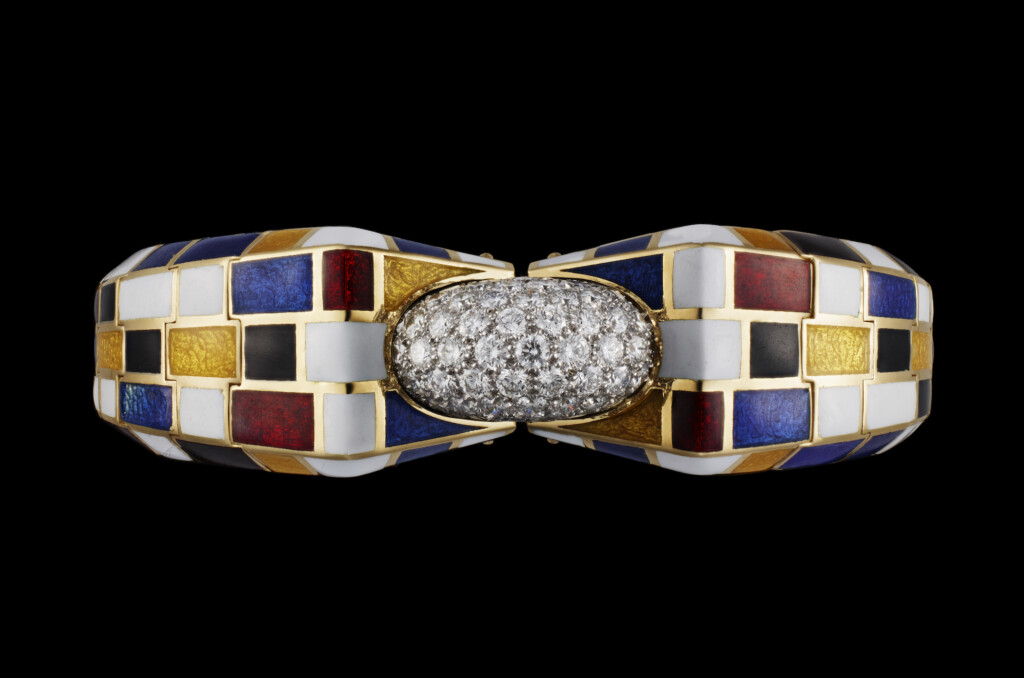It’s funny when you find patterns in life. In 2001, writer and jewelry historian Ruth Peltason was tapped to pen a book about Elizabeth Taylor’s famous collection. For the cover, she and her team selected a film still from Ash Wednesday, in which Taylor is draping a double strand of pearls across her eyes. The necklace was by David Webb. Nearly a decade later, the author was approached to do a book about Webb himself.
“Elizabeth Taylor used to say, ‘Jewelry pieces find each other.’ She would buy something from Bulgari and years later she would buy another Bulgari and they sort of matched,” Peltason explains. “What she was also meaning is that these things keep coming back to us — they connect throughout our lives. I think that’s true.”

Photo by Marc AnthonyThe threads of connection continued. In her research for the 2010 book, David Webb: The Quintessential American Jeweler, Peltason stumbled upon an article written by him titled, “Why Not Hang Gems?”, which argued that jewels should be considered art. Not only did Peltason agree, the concept has inspired her latest exploration of the designer’s work, The Art of David Webb: Jewelry and Culture.
Beyond sharing elements of craftsmanship and creativity, what artwork and bespoke jewelry share is an ability to display a one-of-a-kind piece, be it on a wall or a body. “That was in fact some of the motivation when artists were making jewelry, because finally you could wear your [artwork],” Peltason explains. She recalls an instance in which the gallerist Arne Glimcher asked French artist Jean Dubuffet for a rendering. He then sent the sketch to Webb, requesting a brooch as a present for his wife. Webb obliged (although he swapped out Dubuffet’s suggested white enamel for diamonds). “Bottom line, there is a case where you could wear your painting, because nobody has that brooch.”
Peltason’s earliest memory of jewelry was exploring her grandmother’s collection, asking for the stories and meaning behind each piece. But her first foray into the subject professionally didn’t come until she was in her late 20s. As a young editor at Abrams, she was assigned to work on The Queen’s Jewels: The Personal Collection of Elizabeth II, by Leslie Field.
“Two things came together for me as a little girl and really blossomed as a young editor: the beauty of a piece of jewelry and the stories behind it,” she says. “When I did the QE II book, it was loaded not just with pieces of jewelry and the provenance, but it had stories.” From that moment on, she was routinely assigned to work on jewelry books.
Her latest tome features 120 new images of Webb’s pieces alongside works of art across history that share thematic or visual elements with them. While one might assume sculpture would be the primary comparison (they are both, after all, usually built from stones and metal), Peltason spans a variety of mediums and creative expression, drawing from Webb’s contemporaries and sources that likely inspired him. For example, a diamond necklace reminded her of a dancer. Knowing that the photographer Paul Himmel once shot the New York City Ballet, she paired the necklace with an ethereal Himmel photo of a ballerina. Though the necklace is spectacularly swathed in diamonds, the juxtaposition of images urges the reader to also consider the piece’s unique shape.
Often, we are encouraged to try something different, to venture out. But when you start to notice the patterns in your life — the recurring connections and themes — there’s an opportunity to revisit what you already know and see it in a new light. She’s spent her career covering art, jewelry, even David Webb. And with this new book, Peltason is finally tying it all together.
“I really believe in the power of art…how it makes us civilized creatures, or aspire to be,” she says. “It’s kind of my own personal passion. And with my background in art and David Webb’s article [“Why Not Hang Gems?”], I thought, ‘we’re off to the races.’”

The Art of David Webb: Jewelry and Culture (Rizzoli, $85), by Ruth Peltason is available online and in stores now.




